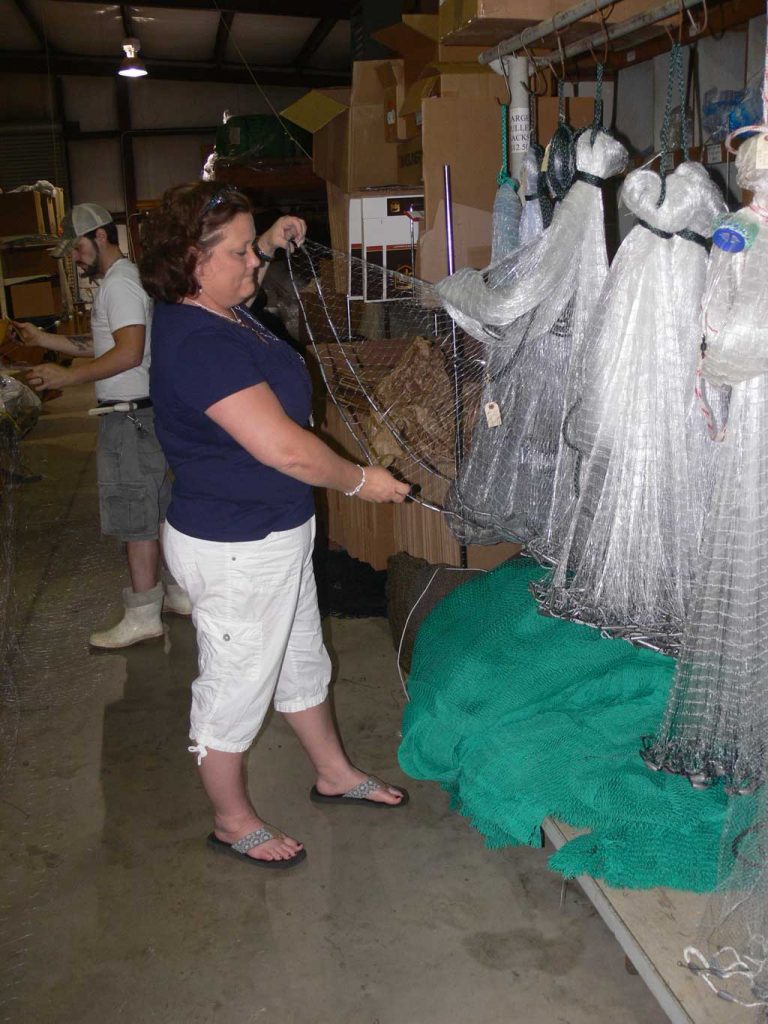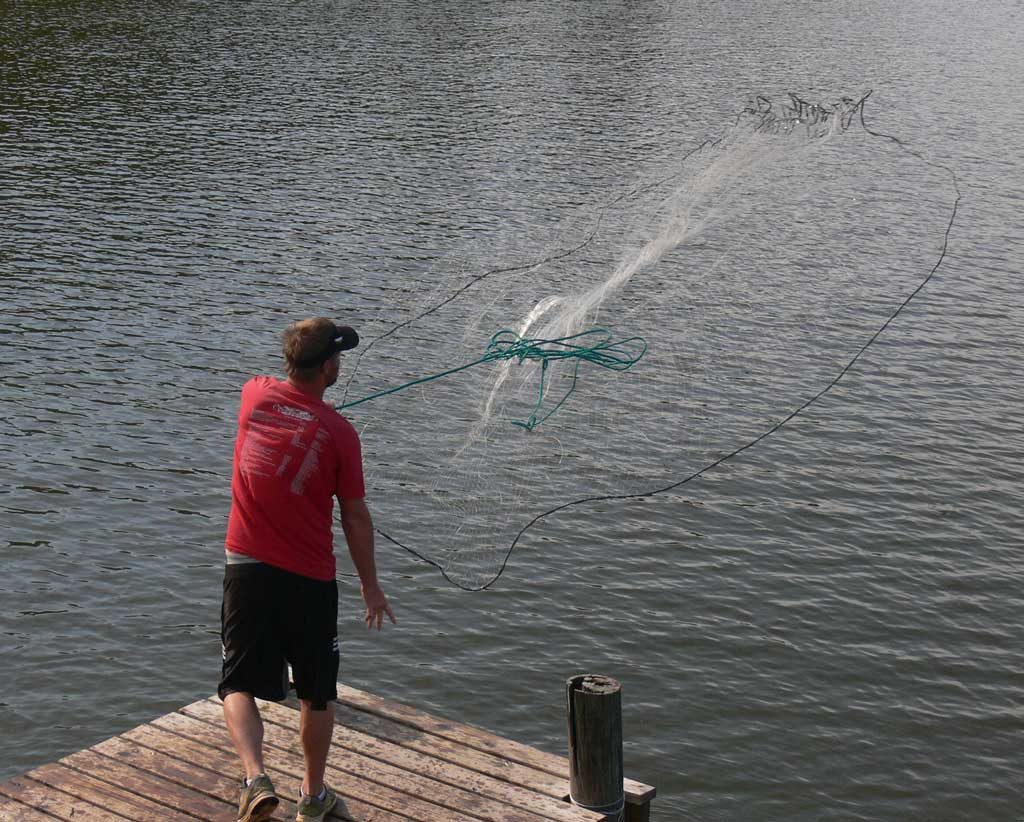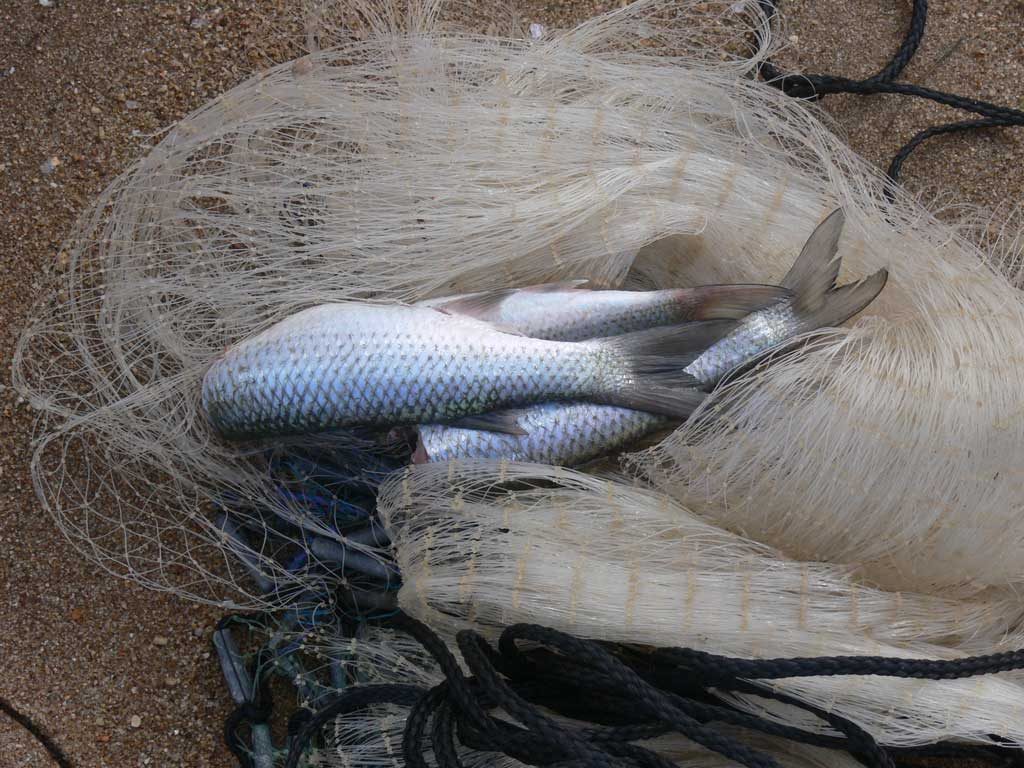Mullet Cast Net Fishing Tips And Tricks
On any day during the spring, summer, and fall on the Gulf Coast, one of the most commonly seen sights is this: standing on a dock or bridge or even the shoreline, a person with a large mullet cast net coiled over his shoulder stares intently at the water.
And waits.
After a while he moves and then, in a very graceful fashion, throws the net out over the water. He retrieves the net by its drawstring.
If the throw was good and the thrower was lucky, the net will contain a number of silver fish that will be immediately deposited in an ice chest. These silver fish—mullet—will become supper.
And a very fine supper it will be, too.
It’s been this way for many years on the Gulf Coast, and folks who have never tried their hand at throwing the net and catching mullet have truly missed one of the great traditions on the Coast.
There are some things that any potential mullet netter needs to know before heading to the water with cast net in hand. It’s not as easy as a good cast-netter makes it look. But mullet are plentiful, and even if the net casting doesn’t go well at first, most folks figure out the throwing technique pretty soon. Catching a mess of mullet for supper then becomes a much more doable enterprise.

Tools of the Trade
Catching fish with some form of cast net is an ancient human activity. Folks have been catching supper with thrown nets for a long, long time. There are several kinds of cast nets, and anglers would be making a mistake to assume that all nets are equal, and that any net will serve in all situations.
Cast nets come in a wide range of prices, too. We can go to the big box store down the road and buy cast nets for not too much money. However, these nets may not be the best cast net for mullet.
As in most kinds of fishing equipment, with cast nets what you get is pretty much what you paid for. Cheap nets may not be the best choice, especially for folks just learning to throw a net.
“Many times, a slow sinking net will miss mullet when the spooked fish simply swim from under the thrown net before it can sink to the bottom and trap the mullet.”
Among the many variables of cast net design, a very important point of any net is the size of the mesh. If the cast net is designed for catching bait—shrimp and minnows, usually— the mesh will be smaller. This means the net will sink slowly. Many times, a slow sinking net will miss mullet when the spooked fish simply swim from under the thrown net before it can sink to the bottom and trap the mullet.
It’s hard to select the right net without expert advice.
Coincidentally, potential cast netters have a good source of information close at hand.
Brunson Net and Supply in Foley, Alabama has been making and selling nets for many years. They have some good directions for getting started in the cast netting game.
Trudy Hesse, who with her husband Stephen owns Brunson Net and Supply, says,
“Choosing the right cast net size for mullet depends on the age of the persons throwing. Young kids have smaller hands, so they should start with a small bait net. Then, as the person gets older and stronger, move up to larger nets.”

She adds, “For a good adult size, try an eight- or nine-foot net for wading, and a ten-foot net for throwing off a dock. We sell a lot of 12-foot nets as well.”
Material for cast nets is pretty much the same, regardless of the makers. Cast nets will usually be made of monofilament.
Most store-bought nets are machine sewn, and there’s not much attempt with these nets to make the taper of the nets’ panels come together to create the optimum landing and spread of the thrown net.
Trudy says, “The hand-made tapers in a good cast net make the panels have the same bottom radius, but the top part that comes up to the thrower’s hand are extra-tapered. This cuts down on the bulk of the net and the net lies flat when thrown.”
A good mullet net will have mesh in one-inch square or two-inch stretched size. This larger mesh allows the net to sink faster than small bait-net mesh, and this helps insure that mullet will not be able to escape.
When asked her best advice for potential mullet netters, Trudy says us, “Buy a quality net. Get the right size for each thrower. Come and talk to us here at Brunson’s. We’ll help you get the right net for your individual use.”
Catching Mullet With A Cast Net
Finding mullet is not hard, they are everywhere on the Alabama Gulf Coast.
However, finding good places to net mullet can be harder. Throwing a net over a rough and snaggy bottom is a good way to lose a net, or at least tear up a net.
The bottom for good netting needs to be smooth, level, and free of snags, rocks or other structure.
Some traditionally good locations for cast netting in Alabama are the Fairhope Pier, the pier at Dauphin Island near Fort Gaines, and some of the best mullet netting comes from private boat docks along the ICW and the shores of Mobile Bay.
“For best netting, the water either needs to be stained a bit, or have a bit of a wind-chop to ruffle the surface and cut down on the vision of mullet.”
A problem with netting mullet comes when the water is clear. Clear water makes it very easy to see the mullet, but it also makes it easy for the mullet to see the netter. When a school of mullet sees a net flying overhead, they move like rockets and usually outrun the fall of the net.
For best netting, the water either needs to be stained a bit, or have a bit of a wind-chop to ruffle the surface and cut down on the vision of mullet.
Casting the mullet net is a skill that takes some work. In fact, it takes a lot of work. The best way to imagine the throwing of a mullet net is to imagine throwing a giant Frisbee. The whole arm must work together with a sharp twist of the wrist to create the wide, flat circle of the net that best traps mullet.
The best way to learn how to throw a mullet net is to spend some time with a veteran cast-netter. An experienced thrower will make the whole process look very easy, and an experienced thrower can give good advice to a beginner when throwing problems come up, which is inevitable.

How to Cook Mullet—the Best Part
Cast-netting mullet is fun, and it’s a good way to keep cool in summer because the one thing that is guaranteed from throwing a cast net is that the thrower will be soaking wet from the water that comes in with thrown nets as they are retrieved.
But the big draw to castnetting mullet is the fish itself.
Mullet is a delicious fish, when fresh. Perhaps more than any other kind of seafood, mullet must be cooked and eaten fresh. Mullet does not freeze well, and mullet that is not fresh is pretty bad stuff. Also, mullet which are caught in fresh water do not taste nearly as good as mullet caught in salty water.
So, how can we tell if a mullet is fresh enough to eat? Look at its eyes; if they are cloudy and have started to sink in, then pass on that fish.
Also, when cleaning the mullet, look at the dark line under the skin that runs from the head of the fish to the tail. This line should be a clear red color. If the line has started to turn a brown color, pass on the fish. It’s time to throw the net anew and net some fresh mullet to eat.
A very unique thing about mullet is that they have gizzards; just like a chicken.
And just like chicken gizzards, mullet gizzards are delicious when cooked up right. The gizzard should be removed during cleaning of the fish and then opened and cleaned again, just like chicken gizzards. Then the gizzards can be rolled in batter along with the cleaned fish. For some folks, the gizzards are the best parts of the fish.
Now, how should mullet be cooked? Let’s keep it simple.
First and foremost, there are few species of fish that fry up better than mullet. Big fall-run mullet can be filleted and the fillets dipped in a batter and deep-fried. Mullet fillets go very well with a side of cheese grits.
Smaller mullet can be scaled, gutted and headed before splitting the fish and opening the fish like a book. Then the whole small mullet can be dredged in milk, rolled in cornmeal with just a touch of Tony’s seasoning, and deep-fried. By the way, this is my personal favorite way of preparing mullet. Small fried mullet go very well with anything on the side, but I like a nice coleslaw and some cornbread.
A much more time-consuming but delicious way of preparing mullet is the old-time technique of smoking the fish.
Smoking mullet takes some practice and trial and error. Again, it’s imperative that the mullet be as fresh as possible. The fish is gutted, headed, and split. The skin and scales are left on to help protect and flavor the fish during smoking.
The fish is then seasoned on the flesh side. Just what seasoning mix used is up to the cook. Some folks make their smoked mullet very spicy and hot. Others go for a gentler, smokier flavor with less heat in the spice mix.
The seasoned mullet is then placed on racks over a low, smoky grill and allowed to very slowly soak up the flavor of the wood being used. I like pecan wood for my smoked mullet.
After a few hours (how long to smoke the mullet is extremely variable), the smoked mullet is removed and put on a platter. Some cold bubbly beverages should be opened, after which the smoked mullet disappears quickly. Bon appetit!
Smoked mullet can be kept in a refrigerator for a couple of weeks easily, and leftover smoked mullet makes great sandwiches with cheese, fresh lettuce, and whatever sandwich spread is preferred. Leftover smoked mullet also works well to add to casseroles and seafood dips.
As an ingredient in a gumbo or etoufee, smoked mullet is impossible to beat. There is a world of things to do with smoked mullet in the kitchen, and they’re all good.
So the ancient and honorable tradition of castnetting and cooking mullet is one of the best things about living on the Gulf Coast of Alabama. A platter of fresh-cooked mullet is just about the best way to promote another great day outdoors.



